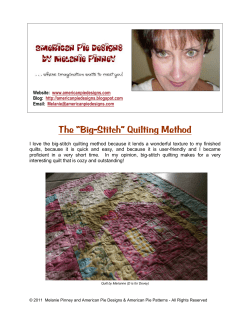
FREE machine needles Needle Sizes Anatomy of a Machine Needle
FREE www.dritz.com Anatomy of a Machine Needle Shank The shank is the upper portion of the needle that is inserted into the machine. The front is rounded and the back is flat. Check your machine manual for instructions on properly inserting the needle into your sewing machine. Shaft The shaft is the lower portion of the needle that begins at the base of the shank and extends to the point. The needle size is determined by the shaft diameter. Groove The groove is the indentation located on the front of the needle. The thread is protected in the channel as the needle passes through the fabric. Scarf The scarf is the indentation on the back of the needle above the eye. The scarf allows the bobbin thread to pass closely to the needle eye catching the needle thread to create a stitch. Eye The eye is the hole in the lower portion of the shaft. The thread passes from the front to the back of the needle through the eye. Select a needle with the appropriate size eye to accommodate the thread you are using. The thread should flow freely through the eye. Point The point is the tip of the needle that penetrates the fabric. Needle points are designed to penetrate different fabric types. Needle Sizes Needle packages are marked with two size numbers. The higher number is the European metric system and defines the needle shaft diameter in fractions of a millimeter. The lower number is the American numbering system. machine needles Exception: For Twin or Triple Needles the first number is the distance between the needles in millimeters. The second number is the European needle size. European 60 65 70 75 80 90 100 110 American 8 9 10 11 12 14 16 18 Fabric Weights Select size of needle based on fabric weight. The finer your fabric weight, the lower the needle size to use. Fabric Very Lightweight Lightweight Medium-weight Heavyweight Very Heavyweight Needle Size 8 or 9 9, 10 or 11 12 or 14 14 or 16 16 or 18 Due to seasonal nature of project, supplies are available for a limited time only. Please read all instructions prior to beginning; read and follow all manufacturers’ instructions for all tools and materials used. Provide adult supervision if children participate in this and all craft projects. Because Jo-Ann Stores, Inc. has no control over the use of materials and tools, nor surroundings, during construction of projects, Jo-Ann Stores, Inc. disclaims any liability for injury, damage or other untoward results. Content of this project sheet is presented in good faith, but no warranty is given, nor results guaranteed. ©2007 Jo-Ann Stores, Inc. All rights reserved. Choosing the Right Machine Needle Dept. 2170 • P507-215 reorder: machine accessories #1 more projects available at Joann.com Specialty Needles Selecting Machine Needles Machine needles vary according to the type of point and size or thickness of needle. Select your needle for the type of fabric you will be sewing and then choose the size of needle for the weight of fabric and type of thread. Denim/Jeans Very sharp point and stiff shank for stitching tightly woven fabrics like denim, canvas and multiple fabric layers. Also available as a double needle. Stretch Special design prevents skipped stitches on swimwear and knit fabrics that contain spandex or Lycra® as well as synthetic suedes. Types of Machine Needles Hemstitch/Wing Wide “wings” on sides of needle create openwork stitching in tightly-woven fabrics, such as linen and batiste. Use for hemstitching and heirloom embroidery. Also available as a double needle. General Purpose Universal Point Point is slightly rounded. All-purpose needle for sewing wovens and knits Ball Point Point is more rounded than Universal, designed to slide between yarns of knit fabrics without snagging. Leather Wedge shaped point pierces real leather & suede, creating small stitch holes and strong seams. Never use on woven or knit fabrics. Sharp/Microtex Sharp point for perfectly straight stitches. Ideal for silks, microfibers and heirloom sewing. Universal Point Machine Embroidery Designed with a special scarf and large eye to prevent shredding and breakage when stitching dense designs with rayon and special machine embroidery threads. Also available as a double needle. Ball Point Metallica Special scarf prevents skipped stitches; the large eye accommodates heavier threads and the large groove prevents shredding of delicate metallic threads. Also available as a double needle. Sharp Needles shown are not actual size Quilting Tapered needle with sharp point for stitching through multiple fabric layers and intersecting seams. Topstitch Extra-sharp point with an extra-large eye and large groove to accommodate topstitching thread. Double (Twin) & Triple Needles Double and triple needles are designed with two or three shafts on a crossbar that extends from a single shank. Use for pintucking, heirloom sewing, decorative topstitching and hemming. Note: Sewing machine must have zigzag capabilities in order to use twin and triple needle, even when straight stitching. Available stitch width is limited due to wider spread of needle positions. Test stitch first by manually turning the hand wheel. How Often Should I Change My Needle? Always use a new needle for each sewing project. A dull needle or one that has a burr can cause the thread to break or snag the fabric. Bent needles can break or cause skipped stitches.
© Copyright 2025









